Digital Media Winter Institute 2018
SMART Data Sprint: Interpreters of Platform Data
29 January – 2 February 2018
Universidade Nova de Lisboa | NOVA FCSH | iNOVA Media Lab
Project title: Femminicidio in Italian media and public debate: Femminicidio in Italian media and public debate
Project leader: Alessandra Cicali
Team members: Andre Mintz | Aylin Sunam | Cristian Ruiz | Cesar Crisosto | Liliana Rosa | Ana Velhinho | Beatrice Gobbo
Project pitch slides: https://docs.google.com/presentation/d/1k-SA-QK_SvI90OSR3Z-EPqyYlR0ViDQyX0IbtEjLfvU/edit#slide=id.p3
»Introduction
»Research Questions
»Dataset Visual Protocol
»Methodology
»Findings
»Conclusion
»References
Key Findings
This is an explorative project, aimed at understanding in which way Italian press and social media represent “femminicidio” and violence against women, especially through images.
In order to do that, we used five keywords, associated to different semantic areas: “femminicidio” (denunciation of social and institutional responsibility for women killings and violence against women) , “crimine di passione” and “delitto passionale” (traditional vision associated to the private dimension and the passional reasons of killings), “violenza di genere” and “violenza domestica” (more general and neutral terms referred to violence against women). Key findings:
-
- Italian newspapers still use terms related to the traditional semantic area, as “crimine di passione” and “delitto passionale”;
-
- We can group images used by newspapers in four different areas: denunciation and public debate, stock images, family, images related to specific chronicle events;
- Social media are prevalently focused on protests and social denunciation, memory or solidarity with victims, asking for Justice.
»IntroductionIn the last years, the use of “femicide” neologism is spreading in the media, as well as in the political and legal spheres and civil society. Documented as “female homicide” at the beginning of XIX century, the term “femicide” has been used by Diana Russel as “the killing of females by males because they are female”, but its recent spread (and evolution in “feminicidio”) is due to Marcela Lagarde and Latin American women movements. According to M. Lagarde (2006) the term has a wider meaning: any kind of violence against women, due to their refuse to accept the traditional women role, associated to social and state tolerance. So the terminological issue corresponds to a social and cultural change in the way to consider crimes against women: from crime of passion (only private sphere) and honor killing (social and state tolerance) to femicide (violation of human rights).
This evolution has been affirmed at the legal level too: UN Declaration on the Elimination of Violence against Women (1993), Istanbul Convention (2011), national laws in Latin American countries. |
» Research Questions
-
- In which way does Italian press represent “femminicidio”? Which words and images do they use?
-
- How do official and unofficial women organizations speak about “femminicidio”?
- Are activists able to influence the media storytelling?/Do the mainstream media and (official and unofficial) activists use different or similar vernaculars/approaches?
» Dataset Visual Protocol
NEWSPAPERS
The dataset for the newspapers part of this project is based in two principal filters:
In the first step, we have selected a eight of the main newspapers in the italian society, Il Corriere della Sera, La Repubblica, La Stampa, Il Fatto Quotidiano, Il Messaggero, QN, Il Mattino, Libero, Il Giornale and ANSA.
Taking into consideration the keywords: Femminicidio; Crimine di Passione; Delitto passionale; Violenza di genere; Violenza domestica, we scraped articles using the DMI tool Google News Scraper for a short period of time (from 01/10/2017 to 31/01/2018). Visualizing it with Raw Graph his first step allowed us to understand relevance and coverage of the topic by these eight main media outlets.
In the second step, we selected 4 newspapers using the following criteria:
-
- Ideological alignment.
-
- Diffusion across Italy.
- Relevance to coverage the topic.
| Selected newspapers |
|
On these four newspapers we conducted images analysis, for the period 01/01/2017 – 01/01/2018. We used the DMI tool Google Scraper to retrieve data, for 5 query terms, but about 50% of the Google’s results did not contain the searched terms. So we filtered it again, scraping for titles, main image, and article descriptions based on OpenGraph metadata.
| GoogleScraper ⇢ | Subquery ⇢ | Scraping for Metadata (og) |
| > Newspaper URLs
> Query terms – femminicidio – crimine di passione – delitto passionale – violenza di genere – violenza domestica |
> Searching the HTML content for the query terms
~50% of Google’s results did not contain the terms |
> Title
> Description > Image |
FACEBOOK//SELECTING RELEVANT PAGES:
We worked on the basis of an “institutions list”, composed by ten of the main women associations in Italy, and using a multiple facebook query for pages that include the keywords “Femminicidio”, “Violenza sulle donne”, “Violenza contro le donne”.
(Netvizz/Period: 1 October 2017- 30 January 2017 ).
On this basis a social network analysis was conducted and we were able to identify the main nodes merging the network of the institutions and the queries (in the table 1)
- Facebook query
⇒ Page Like Network ⇒ relevant pages
- Institution list
| List of relevant pages: Se non ora quando, Di.Re Donne in rete contro la violenza, Zeroviolenza, Casa Internazionale delle donne , Fondazione Pangea onlus, Narrazioni differenti, Abbatto i muri. |
DEFINING THE DATASET:
Then, we scraped data for this relevant pages and the “shortlist” of main Italian media (Il Corriere della Sera, La Repubblica, Il Fatto Quotidiano, Il Giornale) – Netvizz (from 01/01/2015 – 31/01/2018)
Our first dataset included 7.802 media items filtered for the keyword “femminicidio”, from 2013 to the end of 2017. In order to work on the same time period used for newspapers, we selected only the posts referred to 2017, obtaining a dataset of 2.564 posts.
Out of this dataset, we decided to analyze the last quartile considering the engagement of the instagram posts (649 posts).
-
- 649 post used in order to obtain an images scatterplot (engagement/time)
- 2.564 posts analyzed using Image sorter
» Methodology
Finally we focused our attention on image analysis, using three different approaches:
- Images networks analysis
We clustered images by labels, for the four previously selected media outlets, using Google Vision API
- Contents analysis
Using Image Sorter, we analyzed 703 images from Il Corriere della Sera, 476 from La Repubblica, 1229 from Il Giornale, 185 from Il Fatto Quotidiano, 693 from Facebook, 1.105 from Instagram.
- Manual content analysis
» Findings
PRELIMINARY FINDINGS:
NEWSPAPERS
On the web, the main Italian media outlets still use terms that associate women killings to passion and “too much love” and they do it very often. In four months (from 1st October 2017 to 31 January 2018), all the examined media outlets used the expressions “Crimine di passione” (260 times) and “Delitto passionale” (111 times).
The word “Femminicidio” has been used 204 times, in the same period, by Il Fatto Quotidiano (68), La Stampa (62), La Repubblica (27), Il Corriere della Sera (24), Il Giornale (23).
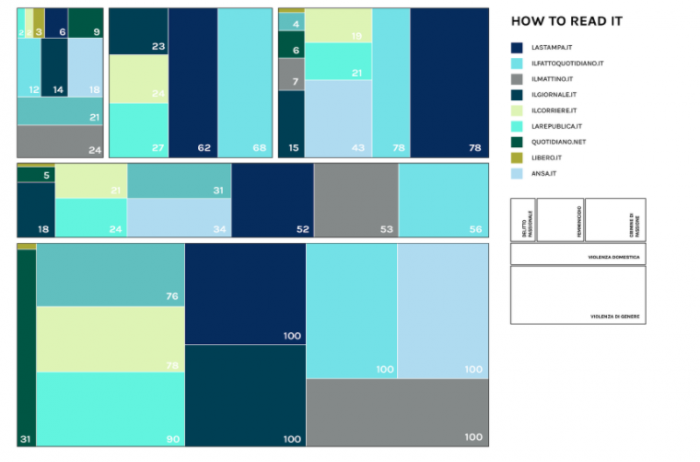
Finally, we argue that the coverage of the topic by the analyzed media outlets is very different: from La Stampa (with all the analyzed terms used 317 times ) to Libero (6).
As we said above, we worked on the basis of an “institutions list”, composed by ten of the main women associations in Italy, and using a multiple facebook query for pages that include the keywords “Femminicidio”, “ Violenza sulle donne”, “Violenza contro le donne”.
The resulting network shows very interesting clusters, especially the green one (with the most important territorial women associations, linked by the national network Di.Re) and the pink one (composed by a group of “cultural” women associations, very active on the web and aimed at changing the common women representation, with “Narrazioni differenti” and “Abbatto i muri” as the main important nodes of the cluster).
 Anyway, testing our dataset we discovered the selected institutions don’t frequently use our keywords. We suppose it is due to two different reasons:
Anyway, testing our dataset we discovered the selected institutions don’t frequently use our keywords. We suppose it is due to two different reasons:
-
- the first one linked to the Facebook use (related to events promotion and content sharing, with 436 events and 6.755 link in the examined period )
- on the other hand, we can speculate that the term femminicidio could be associated to specific chronicle events.
IMAGE ANALYSIS:
NEWSPAPERS
Which kind of images? Network and content analysis
Using Google Vision API, we processed the images for descriptive labels and used those labels to draw relationships between images, represented as a bipartite graph. Images and labels being the two types of nodes, the edges were the relationships between images and labels. The network was then visualized in Gephi using the Force Atlas 2 layout and the images were plotted in their relative positions, generating a map of semantic relationships between the images, which as the basis for our analysis.
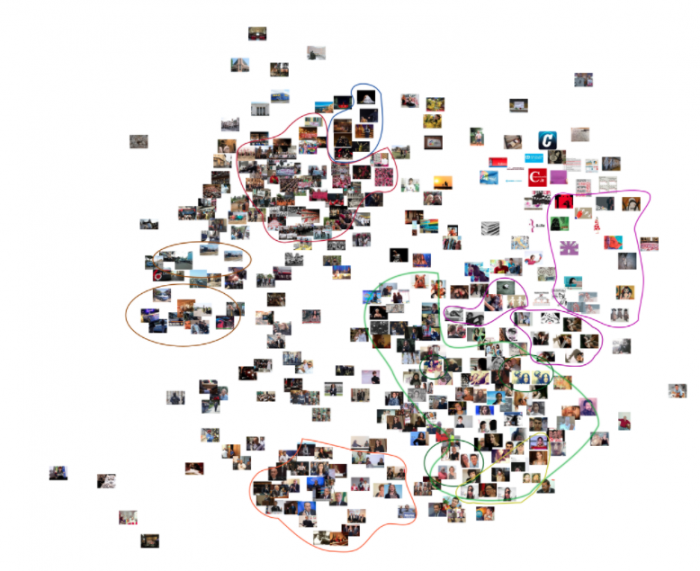
In analyzing these maps, we worked by drawing thematic and formal clusters, which could be taken as categories or semantic groups. Some of the ones identified are described in the following table.
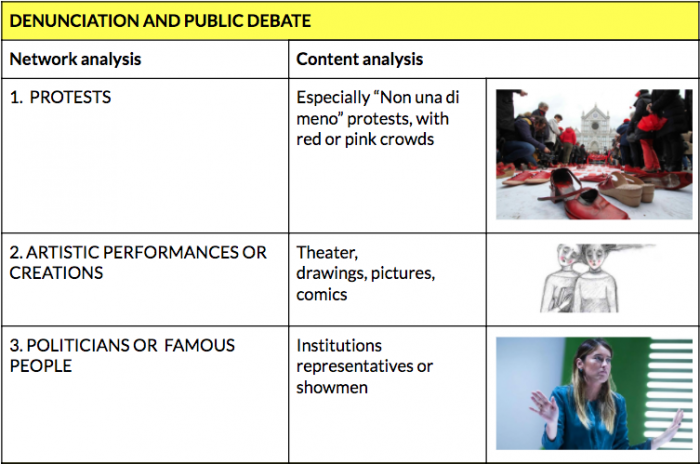

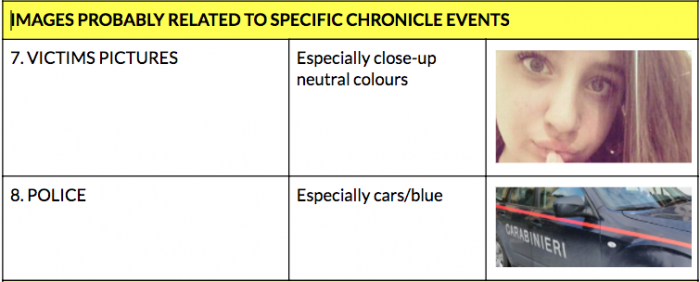
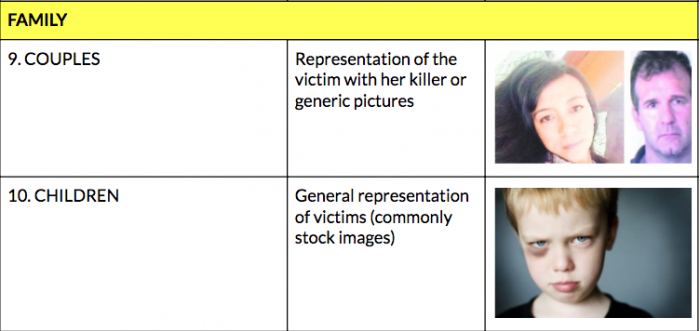
Differences and similarities among the four newspapers
All the clusters are widely represented by the two main Italian newspapers (“Il Corriere della Sera” and “La Repubblica”). “Il Fatto quotidiano” is more focused on protests, politicians or famous people interventions and police images. Finally, the right side newspaper “Il Giornale” stands out because it does not present a “protests cluster” (only few images without the distinguishing features of women movements, as pink colour, logos and symbols ) and for having a bigger number of stereotyped women images.
SOCIAL NETWORKS
The Image sorter analysis has been realized by colour, for Facebook (693 images, for 3 keywords, from the fb pages of a selected group of associations, 2017)* and Instagram (1.105 images related to the keyword #femminicidio, 2017).
Analyzing Instagram images we notice that red is the dominant colour. It is associated to women, blood and it has been used by important international campaigns against violence.
On the social network the word “femminicidio” is clearly related to powerful images aimed at claiming justice, social denunciation, memory or solidarity with victims.

» Conclusion
Visualizing the representation of violence against women on Italian online newspapers and social media, we can find a mix of semantic areas. For newspapers: denunciation and public debate, stock images (with the biggest risk to find stereotyped images, as weak or hurt women), family, images related to specific chronicle events.
Social media are prevalently focused on protests and social denunciation, memory or solidarity with victims, asking for Justice.
»References
-
- Roger, Richard. 2013. Digital Methods. Cambridge, MA: MIT Press.
-
- R. Rogers, “Digital Methods for Web Research,” in Robert A. Scott and Stephen M. Kosslyn (eds.), Emerging Trends in the Behavioral and Social Sciences. Hoboken, NJ: Wiley, 2015.
-
- https://www.coe.int/en/web/istanbul-convention/home
-
- https://femicidiocasadonne.files.wordpress.com (Italian)
